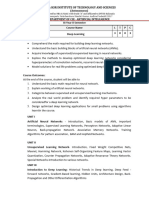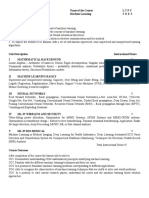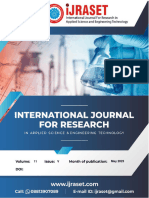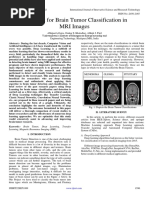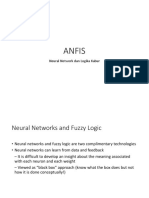Deeplearning
Uploaded by
Jayaprakash B AcharDeeplearning
Uploaded by
Jayaprakash B AcharPhD Computer Science
Research Topic: Development of an Optimising prediction model for Lung
Cancer on non-small cell and small cell lung using multi-modality and
single modality PET scan
Name of the Candidate : Jayaprakash B
Application No : JU2022RPHD10070
Programme : PhD in Computer Science
Specialization Paper II
DEEP LEARNING
Unit – 1: Deep learning basics: Introduction, History, capabilities, the perceptron , Neural
network learning: Back-Propagation , Practical network training , Autoencoders, Batch-
normalization , why does it work? Overfitting and generalization, Artificial Neural
Networks : Introduction, Perceptron Training Rule, Gradient Descent Rule.
12 hours
Unit-2: Convolutional neural networks: Introduction to CNNs, Convolution, Correlation,
Filtering. CNN architectures, Detection and Segmentation , Visualizing and Understanding ,
Advanced CNNs for computer vision. Principles behind CNNs, CNN applications
Introduction to Recurrent Neural Networks: Introduction to RNNs, Unfolded RNNs, Seq2Seq
RNNs, LSTM, RNN. 12
hours
Unit-3: Advanced Deep architectures: Recurrent Neural networks (RNNs) ,Advanced RNN:
LSTM, GRU, Generative Adversarial Networks (GANs) , Deep reinforcement learning,
Visual Question Answering, Visual Dialog , Novel deep methods (Deep internal learning,
Deep image prior).
12 hours
Unit -4: Gradient Descent and Backpropagation: Gradient Descent, Stochastic Gradient
Descent, Backpropagation, Some problems in ANN Optimization and
Regularization :Overfitting and Capacity, Cross Validation, Feature Selection,
Regularization, Hyperparameters.
12 hours
Unit 5: Artificial Neural Networks – Neural network representations, perceptions in neural
networks, multilayer networks and back propagation algorithm, basics of sampling theory,
Bayesian learning introduction, Bayes theorem and concept learning, Maximum likelihood
and Least Squared Error hypotheses, Maximum likelihood hypotheses for predicting
probabilities.
12 hours
Text Book
1. Nithin Buduma, Joe Papa(2022), Fundamentals of Deep Learning: Designing Next-
Generation Machine Intelligence Algorithms – Publisher O'Reilly Media.
2. CHANDRA S.S., VINOD, HAREENDRAN S., ANAND(2021), MACHINE
LEARNING : A PRACTITIONER'S APPROACH, PHI publications
References:
1. Golub, G.,H., and Van Loan,C.,F., Matrix Computations, JHU Press,2013.
Journals:
(Valeti Madhu Babu 2022,), Detection of Cancer and Comparison of Survival Rate of
Patients from CT Images on Long Nodules Data using Novel Support Vector Machine
and 3D Convolutional Neural Network Classification, International Conference on
Sustainable Computing and Data Communication Systems (ICSCDS), IEEE.
(Tao Wei, 2022), Drug Resistance Prediction of Non-small Cell Lung Cancer Based on
Deep Learning, IEEE International Conference on Information Technology,Big Data and
Artificial Intelligence (ICIBA)
(Deepak Rawat 2022), Optimized Deep Learning Model for Lung Cancer Prediction Using
ANN Algorithm, 2022 3rd International Conference on Electronics and Sustainable
Communication Systems (ICESC), IEEE.
(Amrit Sreekumar 2020), Malignant Lung Nodule Detection using Deep Learning,
International Conference on Communication and Signal Processing (ICCSP), IEEE.
(Diksha Mhaske 2019), Deep Learning Algorithm for Classification
and Prediction of Lung Cancer using CT Scan Images, 5th International Conference On
Computing, Communication, Control And Automation (ICCUBEA)
You might also like
- Implementation of Intelligent Model For Pneumonia Detection: Željko KNOK, Klaudio PAP, Marko HRNČIĆNo ratings yetImplementation of Intelligent Model For Pneumonia Detection: Željko KNOK, Klaudio PAP, Marko HRNČIĆ8 pages
- Automated Diagnosis of Brain Tumor Classification and Segmentation of Magnetic Resonance Imaging ImagesNo ratings yetAutomated Diagnosis of Brain Tumor Classification and Segmentation of Magnetic Resonance Imaging Images10 pages
- v1_covered_d57a04ed-1d6d-4ae1-8652-c77c0b267e61-1No ratings yetv1_covered_d57a04ed-1d6d-4ae1-8652-c77c0b267e61-150 pages
- Big Data Deep Learning Framework Using KerasNo ratings yetBig Data Deep Learning Framework Using Keras5 pages
- A Deep Learning Guide To MICCAI 2015 - v2No ratings yetA Deep Learning Guide To MICCAI 2015 - v221 pages
- Stars 4 0 0 0 + Forks 7 0 0 + License MITNo ratings yetStars 4 0 0 0 + Forks 7 0 0 + License MIT19 pages
- Emerging Applications of Artificial Intelligence in Neuro-OncologyNo ratings yetEmerging Applications of Artificial Intelligence in Neuro-Oncology12 pages
- Pneumonia Detection On X-Ray Image Using Improved Depthwise Separable Convolutional Neural NetworksNo ratings yetPneumonia Detection On X-Ray Image Using Improved Depthwise Separable Convolutional Neural Networks9 pages
- Hybridization of Dilated CNN With Attention Link Net For Brain Cancer ClassificationNo ratings yetHybridization of Dilated CNN With Attention Link Net For Brain Cancer Classification7 pages
- Hybrid Model For Detection of Brain Tumor Using Convolution Neural NetworksNo ratings yetHybrid Model For Detection of Brain Tumor Using Convolution Neural Networks7 pages
- Personalized Alzheimer's Disease Progression Prediction With Machine LearningNo ratings yetPersonalized Alzheimer's Disease Progression Prediction With Machine Learning6 pages
- Brain Tumor Detection Using Python: © FEB 2024 - IRE Journals - Volume 7 Issue 8 - ISSN: 2456-8880No ratings yetBrain Tumor Detection Using Python: © FEB 2024 - IRE Journals - Volume 7 Issue 8 - ISSN: 2456-88806 pages
- Dacbt: Deep Learning Approach For Classification of Brain Tumors Using Mri Data in Iot Healthcare EnvironmentNo ratings yetDacbt: Deep Learning Approach For Classification of Brain Tumors Using Mri Data in Iot Healthcare Environment14 pages
- Primary phase Alzheimer's disease detection using ensemble learning modelNo ratings yetPrimary phase Alzheimer's disease detection using ensemble learning model9 pages
- Machine_learning_and_transfer_learning_techniques_for_accura_2024No ratings yetMachine_learning_and_transfer_learning_techniques_for_accura_202414 pages
- Hybrid Improved Fuzzy C-Means and Watershed Segmentation To Classify Alzheimer's Using Deep LearningNo ratings yetHybrid Improved Fuzzy C-Means and Watershed Segmentation To Classify Alzheimer's Using Deep Learning15 pages
- Deep Convolutional Neural Network Framework With Multi-Modal Fusion For Alzheimer's DetectionNo ratings yetDeep Convolutional Neural Network Framework With Multi-Modal Fusion For Alzheimer's Detection13 pages
- Neuro Detect A Deep Learning Model For Comprehensive Brain Tumor Diagnosis and StagingNo ratings yetNeuro Detect A Deep Learning Model For Comprehensive Brain Tumor Diagnosis and Staging8 pages
- Brain Tumor Detection Using Deep LearningNo ratings yetBrain Tumor Detection Using Deep Learning5 pages
- Hybrid-DANet An Encoder-Decoder Based Hybrid Weights Alignment With Multi-Dilated Attention Network For Automatic Brain Tumor SegmentationNo ratings yetHybrid-DANet An Encoder-Decoder Based Hybrid Weights Alignment With Multi-Dilated Attention Network For Automatic Brain Tumor Segmentation12 pages
- Brain Tumor Identification Using Dilated U-Net Based CNN: C PublicationsNo ratings yetBrain Tumor Identification Using Dilated U-Net Based CNN: C Publications12 pages
- Diagnostics: Artificial Intelligence in Capsule Endoscopy: A Practical Guide To Its Past and Future ChallengesNo ratings yetDiagnostics: Artificial Intelligence in Capsule Endoscopy: A Practical Guide To Its Past and Future Challenges12 pages
- DenseNet For Brain Tumor Classification in MRI Images100% (1)DenseNet For Brain Tumor Classification in MRI Images9 pages
- Develop A Hybrid Model Using CNN Transfer Learning & VGG-16 For The Detection of Brain TumorNo ratings yetDevelop A Hybrid Model Using CNN Transfer Learning & VGG-16 For The Detection of Brain Tumor10 pages
- Prediction of Heart Disease Using Machine LearningNo ratings yetPrediction of Heart Disease Using Machine Learning5 pages
- Computational Intelligence and Machine Learning Approaches in Biomedical Engineering and Health Care SystemsFrom EverandComputational Intelligence and Machine Learning Approaches in Biomedical Engineering and Health Care SystemsNo ratings yet
- Physics-Informed Deep Learning - A Promising Technique For System Reliability AssessmentNo ratings yetPhysics-Informed Deep Learning - A Promising Technique For System Reliability Assessment29 pages
- Introduction To Quantum Finance: January 2020No ratings yetIntroduction To Quantum Finance: January 202046 pages
- Personality Prediction Based On Handwriting Using Machine LearningNo ratings yetPersonality Prediction Based On Handwriting Using Machine Learning4 pages
- Deep Learning: Huawei AI Academy Training MaterialsNo ratings yetDeep Learning: Huawei AI Academy Training Materials47 pages
- 2022-Intelligent Prediction of Stuck Pipe Using Combined Data-Driven and Knowledge-Driven ModelNo ratings yet2022-Intelligent Prediction of Stuck Pipe Using Combined Data-Driven and Knowledge-Driven Model16 pages
- Towards Development of An Isfet-Based Smart PH Sensor: Enabling Machine Learning For Drift Compensation in Iot ApplicationsNo ratings yetTowards Development of An Isfet-Based Smart PH Sensor: Enabling Machine Learning For Drift Compensation in Iot Applications12 pages
- Breast Cancer Classification-IEEE PaperNo ratings yetBreast Cancer Classification-IEEE Paper17 pages
- Satellite Image Inpainting With Deep Generative Adversarial Neural NetworksNo ratings yetSatellite Image Inpainting With Deep Generative Adversarial Neural Networks10 pages
- Recognition of Edible Vegetables and Fruits For Smart Home Appliances BASE PAPER 1No ratings yetRecognition of Edible Vegetables and Fruits For Smart Home Appliances BASE PAPER 14 pages
- Advanced Engineering Optimization Through Intelligent TechniquesNo ratings yetAdvanced Engineering Optimization Through Intelligent Techniques836 pages
- Floor Plan Recognition Using Multi-Task Netwrok With Room Boundary Guided AttentionNo ratings yetFloor Plan Recognition Using Multi-Task Netwrok With Room Boundary Guided Attention9 pages
- A Swarm Anomaly Detection Model for IoT UAVs Based on a Multi-modal Denoising Autoencoder and Federated LearningNo ratings yetA Swarm Anomaly Detection Model for IoT UAVs Based on a Multi-modal Denoising Autoencoder and Federated Learning22 pages
- TrueFidelity White Paper JB68676XX-DOC2287426No ratings yetTrueFidelity White Paper JB68676XX-DOC228742615 pages
- Neural-Networks-Overview-365-Data-Science-Course NotesNo ratings yetNeural-Networks-Overview-365-Data-Science-Course Notes14 pages
- On Hyperparameter Optimization of Machine Learning Algorithms: Theory and PracticeNo ratings yetOn Hyperparameter Optimization of Machine Learning Algorithms: Theory and Practice69 pages
- Article - Artificial Intelligence in The Stock MarketNo ratings yetArticle - Artificial Intelligence in The Stock Market19 pages






